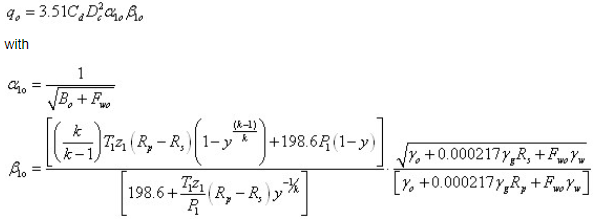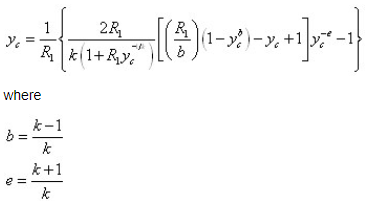Choke sizing applies to single-phase flow and multiphase flow.
Specific heat ratio

where:
Cp = specific heat capacity of gas at constant pressure
Cv = specific heat capacity of gas at constant volume
Both of the above are evaluated at upstream pressure and temperature.
Single-phase flow
Rawlins-Schellhardt
Rawlins and Schellhardt developed a form of equation for gas flow through chokes under critical flow conditions that is dependent only on upstream pressure. Rawlins and Schellhardt based their equation on ideal gas at a standard pressure of 14.4 psia. Correction for non-ideality and for a standard pressure other than 14.4 psia is included in the following equation:

where
qi = gas flow rate, MMscfd
P1 = upstream pressure, psia
T1 = upstream temperature, *R
Ύg = gas specific gravity (air = 1.0)
z1 = gas compressibility factor at upstream conditions
Cf = choke flow coefficient
Multiphase flow
Ashford-Pierce
Ashford and Pierce developed a correlation specifically describing multiphase flow through safety valves and tested it against field data. Their correlation has the form:

where:
Cd = choke discharge coefficient
D = choke diameter, 64th of an inch
Bo = oil formation volume factor, rbbl / bbl
Fwo = water oil ratio, bbl / bbl
T1 = upstream temperature, *R
P1 = upstream pressure, psia
z1 = gas compressibility factor at upstream conditions
RF = producing gas oil ratio, scf / bbl
Rs = solution gas oil ratio, scf / bbl
ᵧ = ratio of downstream pressure to upstream pressure, P2 / P1
k = CF / Cs
Ύo = oil specific gravity (pure water = 1.0)
Ύw = water specific gravity (pure water = 1.0)
Ύg = gas specific gravity (air = 1.0)
This relationship applies both at and above the critical pressure ratio, ᵧc.
Ashford and Pierce further define the critical pressure ratio, ᵧc, as

As this is implicit in Ύc it must be solved iteratively.
The Ashford-Pierce relationship cannot directly be applied here because oil may or may not be one of the flowing phases. However, their relationship for the fluid velocity downstream of the choke gives rise to an alternative approach that is amenable to solution with gas plus one or more liquid phases present:

where:
µ2 = downstream fluid velocity, ft / s
P1 = upstream pressure, psia
k = CF / Cs
ᵧ = ratio of downstream pressure to upstream pressure, P2 / P1
g = mass weight equivalence factor, 32.174 lb ft / lb ft / ls s2
ρf1 = total fluid density at upstream conditions, lb / ft3
ρ1 = liquid density, lb / ft3
Assuming critical flow in the choke throat, the downstream pressure and fluid velocity can be calculated, and with the latter plus the produced fluid ratios, the mass flowrate of each phase is obtainable.
For more information, see references.
Achong
Achong updated Gilbert’s relationship on the basis of data from oil wells in the Lake Maracaibo field of Venezuela. The rate of multiphase flow through a choke and the upstream pressure are, according to Achong, correlated by the following relationship:

where:
P1 = upstream pressure, psia
q1 = liquid flowrate, bbl / d
RP = producing gas liquid ratio, scf / bbl
DC = choke diameter, 64th of an inch
For more information, see references.
Baxendell
Baxendell’s correlation linking the rate of multiphase flow through a choke and the upstream pressure – and fundamentally an update of the Gilbert correlation – is:

where:
P1 = upstream pressure, psia
q1 = liquid flowrate, bbl / d
RP = producing gas liquid ratio, scf / bbl
DC = choke diameter, 64th of an inch
For more information, see references.
Gilbert
Gilbert developed a generalized correlation based on data from flowing oil wells in the Ten Section field of California. The rate of multiphase flow through a choke and the upstream pressure can be correlated, according to Gilbert, by the following relationship:

where:
P1 = upstream pressure, psia
q1 = liquid flowrate, bbl / d
RP = producing gas liquid ratio, scf / bbl
DC = choke diameter, 64th of an inch
For more information, see references.
Ros
The rate of multiphase flow through a choke and the upstream pressure are, according to Ros on the basis of Gilbert’s and other prior work, correlated by the following relationship:

where:
P1 = upstream pressure, psia
q1 = liquid flowrate, bbl / d
RP = producing gas liquid ratio, scf / bbl
DC = choke diameter, 64th of an inch
For more information, see references.